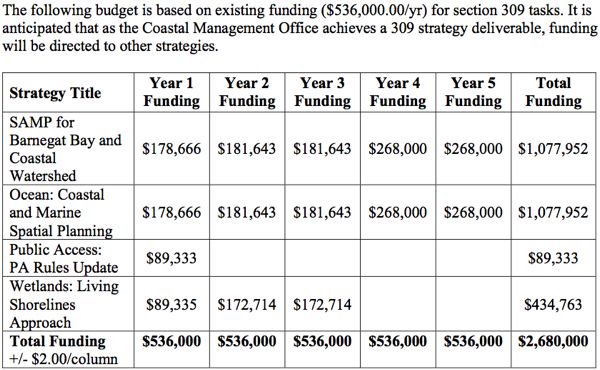Gov.’s Barnegat Bay Plan Displaced Prior Funding & Priority On Coastal Hazards
With all the focus on the federal Sandy Rebuild Task Force Report recommendations, it’s time to get back in the weeds to explain crucial issues.
I seem to have had some problem communicating this in policy and regulatory words, so, keeping it simple, perhaps the above chart will help.
The chart is from the NJ DEP “New Jersey Section 309 Strategy: 2011 – 2015″.
Look at it closely – do you see coastal hazards or climate change mentioned or funded?
That Strategy is required under the federal Coastal Zone Management Act and is submitted to the National Oceanic and Atmospheric Administration (NOAA) for review and approval.
It is NJ’s official State strategy for coastal zone management. NOAA funds and oversees the programs the State includes in the strategy.
The above chart demonstrates the following crucial facts that have gone completely un-noticed by the public and media:
- Despite the fact that the NJ coast is highly developed and highly vulnerable, the Christie Administration reversed longstanding policy and failed to consider coastal hazards in their strategy and priority program funding decisions;
- The Christie Administration failed to consider climate change, sea level rise, and more frequent and intense storms in coastal planning and management;
- Gov. Christie’s personal political decision to prioritize and fund the development of a “Special Area Management Plan” (SAMP) for Barnegat Bay consumed 1/3 of total available funds and displaced other previously high priority DEP initiatives;
- The Barnegat Bay SAMP decision diverted resources, DEP staff, and priority focus from a prior “Coastal Community Vulnerability Assessment Protocol – NJ Coastal Communities Resilience Demonstration Project” pilot study with 3 shore towns. The objective of this pilot study was to provide guidance and technical assistance so that shore towns could reduce vulnerability to and damage from major coastal storms like Irene an Sandy;
- DEP Commissioner Martin decided to make “Coastal and Marine Spatial Planning” a priority and allocate 1/3 of available funds to that project. Again, this decision diverted funds and priority focus from work on other coastal hazard, vulnerability assessment, and adaptation planning that was under development by DEP in various forms;
- DEP Commissioner Martin severed the Office of Coastal Management from the Commissioner’s Office and buried it in the land use permit programs, while forcing out veteran coastal management experts;
- As a result of these decisions by the Governor and Commissioner, DEP did virtually no work on coastal hazard planning; vulnerability assessment; climate change or adaptation planning.
And as a result of all that, NJ shore communities were more vulnerable, less prepared and suffered more damage from Sandy than necessary.
Basic accountability demands that we keep this in mind, particularly in ight of the recommendations of the HUD Sandy Rebuild Task Force Report.
If those recommendations are not mandatory – either as conditions of federal funding, federal flood insurance, or federal regulations – there is very little likelihood that they will be embraced and implemented by the Christie Administration, given this prior incompetence and pattern of failure.


Pingback: pengertian dokumentasi
Pingback: perbedaan demokrasi langsung dan tidak langsung
Pingback: observasi adalah
Pingback: pengertian observasi
Pingback: pengertian komunitas
Pingback: pengertian estetika
Pingback: contoh karangan
Pingback: pengertian keterampilan
Pingback: pengertian bukan warga negara
Pingback: pengertian demonstrasi
Pingback: pengertian budaya
Pingback: limbah domestik
Pingback: dampak kenakalan remaja
Pingback: contoh qiyas
Pingback: pengertian hasil belajar
Pingback: pengertian komunitas
Pingback: cheap nike free 3.0
Pingback: nike free womens